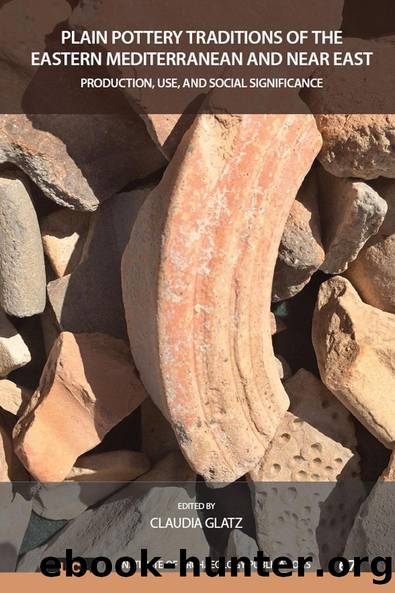Plain Pottery Traditions of the Eastern Mediterranean and Near East by Claudia Glatz

Author:Claudia Glatz [Glatz, Claudia]
Language: eng
Format: epub
ISBN: 9781629580906
Barnesnoble:
Goodreads: 23681836
Publisher: Taylor & Francis
Published: 2015-05-15T00:00:00+00:00
6 Conspicuous Consumption of Inconspicuous Pottery: The Case of the Late Bronze Age Southern Levant
Sharon Zuckerman
The Late Bronze Age (1550â1150 BC) was a period of intensive political and social interaction in the eastern Mediterranean and the southern Levant. Polities organised around the palatial centres of empires (the Hittite, Egyptian, Assyrian and Babylonian), and the petty kingdoms of Cyprus, the Levantine coast and the southern Levant were involved in an intricate web of international relations in which they exchanged letters, diplomatic gifts, ideas and mutual influences (Bunimovitz 1995; Liverani 2008). The rulers of these polities held communal feasts and public rituals as a means of legitimising their rule and conspicuously showing their political and social power. Such feasts are depicted in iconographic works and described in written documents (Yasur-Landau 2005; Zuckerman 2007b). Residues of such communal feasts are represented in the archaeological record through the assemblages of excavated structures, which served as loci for such events. The material residues of feasts include archaeozoological and archaeobotanical remains, as well as luxury objects made of precious materials and vessels used for the storage, preparation and consumption of food and drink (Hayden 2001; Dabney et al. 2004). An important place, at least in terms of their relative quantities, is held by ceramic vessels. These form the majority of every assemblage connected to feasting activities, and their sheer quantity is often the main reason for the interpretation of public rituals or feasting for an assemblage.
In the following, I discuss the role of plain pottery vessels in the public rituals and communal feasts that were conducted in the monumental structures of the Late Bronze Age southern Levant. As a starting point and a case study, the discussion is based on the results of the renewed excavations at Hazor, the largest Canaanite kingdom of the southern Levant.
Download
This site does not store any files on its server. We only index and link to content provided by other sites. Please contact the content providers to delete copyright contents if any and email us, we'll remove relevant links or contents immediately.
| Coatings, Ceramics & Glass | Cosmetics |
| Fluid Dynamics | Plant Design |
| Plastics | Unit Operations & Transport Phenomena |
Whiskies Galore by Ian Buxton(40552)
Introduction to Aircraft Design (Cambridge Aerospace Series) by John P. Fielding(32353)
Small Unmanned Fixed-wing Aircraft Design by Andrew J. Keane Andras Sobester James P. Scanlan & András Sóbester & James P. Scanlan(32152)
Craft Beer for the Homebrewer by Michael Agnew(17464)
Turbulence by E. J. Noyes(7062)
The Complete Stick Figure Physics Tutorials by Allen Sarah(6651)
Kaplan MCAT General Chemistry Review by Kaplan(6073)
The Thirst by Nesbo Jo(5805)
Bad Blood by John Carreyrou(5788)
Learning SQL by Alan Beaulieu(5434)
Weapons of Math Destruction by Cathy O'Neil(5058)
Man-made Catastrophes and Risk Information Concealment by Dmitry Chernov & Didier Sornette(4756)
iGen by Jean M. Twenge(4708)
Digital Minimalism by Cal Newport;(4587)
Life 3.0: Being Human in the Age of Artificial Intelligence by Tegmark Max(4526)
Audition by Ryu Murakami(4114)
Electronic Devices & Circuits by Jacob Millman & Christos C. Halkias(4056)
1,001 ASVAB Practice Questions For Dummies by Powers Rod(4050)
Pale Blue Dot by Carl Sagan(4024)
